The Newburyport Haunted Schoolhouse
Oct 16th, 2017 by bachmann
It would seem, then, that at last we have a veritable ghost, — a pure and unquestionable visitor of semi-spiritual material. It has appeared, at various times, in a small school-house in Charles Street, in Newburyport, and the evidence regarding it is too lucid and consistent to be passed by. -Loring, publisher Boston
Newburyport, the strange, conservative, eccentric, and handsome little city of the East, is again setting the world astir in supplying the strangest of strange phenomena: a Haunted School-house, a visible phantom of a murdered boy, with all the dread and alarming accompaniments. – H.P. Davis
The Haunted Schoolhouse at Newburyport, a pamphlet produced by Loring publishers of Boston in 1873, tells the story of unexplained happenings at a schoolhouse in Newburyport, MA. The students and teacher reported knocking sounds, floating objects, and apparitions. According to the story, a student and teacher finally meet the ghost responsible, possibly a former student at the school: “The figure was that of a boy of thirteen. The visage was remarkably pale, the eyes were blue, the mouth sad, and the whole effect was that of extreme melancholy. The general picture was that of a child prepared for burial and prepared, moreover, in a poor and makeshift way”.
The boys saw it first. It appeared at the partition window that had been uncovered, and Miss Perkins’ attention was called to it. She at once recognized the same pale boy in the same dress. She instantly called upon the largest lads to look at it carefully and to note its bearing, its behavior, and its description. Then she went into the entry. She perceived the same figure, though now at full length, but it eluded her, despite her attempts to seize it, and it faded away and was lost.
Famous celebrities like Oliver Wendell Holmes came to try to debunk the story, but were unable to provide an explanation. At a meeting of the school committee, held Monday evening, February 24, 1873, recommended that a vacation of three or four weeks be allowed Miss Lucy Perkins, the teacher, and a substitute employed to take her place.
Miss Perkins, the teacher. She has suffered much from anxiety, but more from the doubts of those who have persistently questioned her in regard to these matters. It has been no mean task to hold the school together, and to carry it on amid the mysterious troubles, and the draughts upon her nervous system have been many and large. Few women could have displayed so much physical courage as she has…
After her departure, there were no further reports of ghosts in the schoolhouse.
- Description:
- The haunted school-house at Newburyport, Mass. Boston :: Loring, publisher,, 1873.
- Persistent Link:
- http://nrs.harvard.edu/urn-3:FHCL:32071269
- Repository:
- Widener Library
- Institution:
- Harvard University
- Description:
- Davis, H. P. author. Expose of Newburyport eccentricities, witches and witchcraft the murdered boy, and apparition of the Charles-street school-house. [Massachusetts?] : [publisher not identified], 1873.
- Persistent Link:
- http://nrs.harvard.edu/urn-3:FHCL:32071235
- Widener Library
- Institution:
- Harvard University

